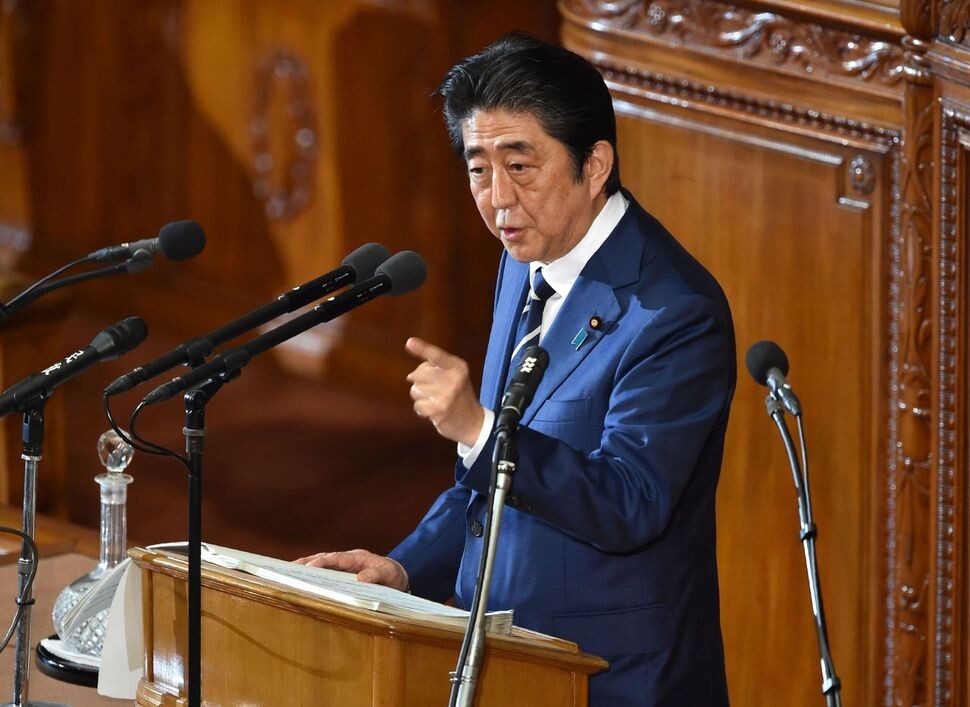hankyoreh
Links to other country sites 다른 나라 사이트 링크
[News analysis] In policy speech, Japan’s Abe moves closer to Constitutional amendment

During his New Year’s policy speech before the Japanese Diet on Jan. 20, Japanese Prime Minister Shinzo Abe underscored his commitment to revising the country’s “Peace Constitution.” Abe applied the new phrase of “our bilateral international commitments until now” to South Korea, which appears to express wariness about recent discussion inside South Korea about renegotiating the comfort women agreement with Japan.
“This is the 70th anniversary of the enforcement of the [Japanese] Constitution,” Abe said during his policy speech on Jan. 20. “We need to deepen concrete discussion in the Constitutional review commission in the House of Representatives to propose a plan to the people about how we will move into the next 70 years.”
By these remarks, Abe declared his intention to revise the Peace Constitution to turn Japan into a country that can legally wage war. The Liberal Democratic Party and other parties in favor of amending the Constitution already hold enough seats in the House of Representative and the House of Councillors to propose a Constitutional amendment (this requires at least two-thirds of seats in both houses).
The core of the Constitutional amendment that Abe has in mind is revising Article 9 of the Peace Constitution, which rejects the right of belligerency and the possession of an army. The draft of the 2012 Constitutional amendment prepared by the Liberal Democratic Party, to which Abe belongs, would have revised Article 1 to redefine the emperor of Japan, who is currently the “symbol” of Japan, as the country’s “commander in chief.” It would also have revised Article 9 to turn the Japanese Self-Defense Forces into the National Defense Force, an official army. This would gut the Peace Constitution, which rejects the right of belligerency and the possession of an army. If the Japanese Constitution were to be amended in such a fashion, Japan would be reborn as a country that can go to war, which it currently cannot do.
However, it will not be easy for Abe and the Liberal Democrats to push through the 2012 draft amendment in its present form. There is pushback not only from the Democratic Party, Abe’s political opposition, but also from inside the Liberal Democrats. An even greater obstacle is the concern of the international community about Japan’s perceived militarism.
For this reason, Abe and the Liberal Democrats could take the approach of dividing Constitutional reform into two stages. This would involve postponing the key revision of Article 9 and starting by only amending the articles about which there is little controversy, such as the clause about emergency situations, and then amending Article 9 at a later time, when the mood has been set. That indicates just how committed Abe is to amending Article 9.
“Building up mutual trust and our bilateral international commitments until now, we will deepen a future-oriented cooperative relationship for a new era,” Abe said on Jan. 20 in regard to South Korea. Abe’s reference to “bilateral international commitments” appears to be designed to shut down recent discussion in South Korea about renegotiating the comfort women agreement with Japan.
Foreign Minister Fumio Kishida, who delivered an address to the Diet on foreign affairs after Abe’s speech, expressed his “extreme regret” for the comfort woman statue in front of the Japanese consulate in Busan. Kishida also said that he would “continue to strongly urge South Korea that both it and Japan should take responsibility for and implement the agreement about the comfort women.”
By Cho Ki-weon, staff reporter
Please direct questions or comments to [english@hani.co.kr]

Editorial・opinion
![[Column] Has Korea, too, crossed the Rubicon on China? [Column] Has Korea, too, crossed the Rubicon on China?](https://flexible.img.hani.co.kr/flexible/normal/500/300/imgdb/original/2024/0419/9317135153409185.jpg) [Column] Has Korea, too, crossed the Rubicon on China?
[Column] Has Korea, too, crossed the Rubicon on China?![[Correspondent’s column] In Japan’s alliance with US, echoes of its past alliances with UK [Correspondent’s column] In Japan’s alliance with US, echoes of its past alliances with UK](https://flexible.img.hani.co.kr/flexible/normal/500/300/imgdb/original/2024/0419/2317135166563519.jpg) [Correspondent’s column] In Japan’s alliance with US, echoes of its past alliances with UK
[Correspondent’s column] In Japan’s alliance with US, echoes of its past alliances with UK- [Editorial] Does Yoon think the Korean public is wrong?
- [Editorial] As it bolsters its alliance with US, Japan must be accountable for past
- [Guest essay] Amending the Constitution is Yoon’s key to leaving office in public’s good graces
- [Editorial] 10 years on, lessons of Sewol tragedy must never be forgotten
- [Column] A death blow to Korea’s prosecutor politics
- [Correspondent’s column] The US and the end of Japanese pacifism
- [Guest essay] How Korea turned its trainee doctors into monsters
- [Guest essay] As someone who helped forge Seoul-Moscow ties, their status today troubles me
Most viewed articles
- 1[Column] The clock is ticking for Korea’s first lady
- 2[Correspondent’s column] In Japan’s alliance with US, echoes of its past alliances with UK
- 3After 2 months of delayed, denied medical care, Koreans worry worst may be yet to come
- 4[Column] Has Korea, too, crossed the Rubicon on China?
- 5[Editorial] When the choice is kids or career, Korea will never overcome birth rate woes
- 6Samsung barricades office as unionized workers strike for better conditions
- 7US exploring options for monitoring N. Korean sanctions beyond UN, says envoy
- 8US overtakes China as Korea’s top export market, prompting trade sanction jitters
- 9[Photo] Smile ambassador, you’re on camera
- 10Hong Se-hwa, voice for tolerance whose memoir of exile touched a chord, dies at 76